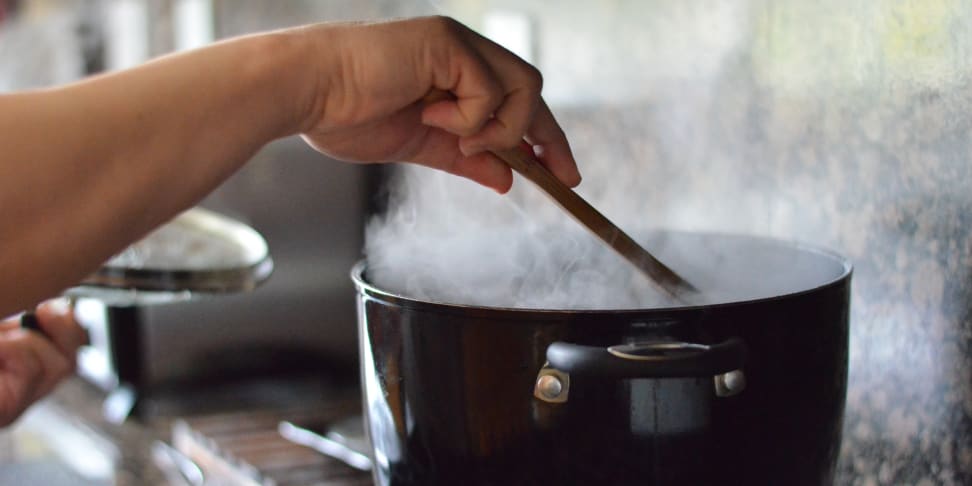5 Common Cooking Mistakes and How to Avoid Them
Are your kitchen errors harming your eats?
 Credit:
Flickr user "nicoleabalde"
Credit:
Flickr user "nicoleabalde"
Products are chosen independently by our editors. Purchases made through our links may earn us a commission.
Even the best cooks make mistakes. Cooking is a science, and even the tiniest, most innocuous-seeming error can ruin a dish. That’s a fact.
We’ve already written about what to do when your oven can't seem to cook anything right, but sometimes the fault lies with the cook, not the tools.
Are you making mistakes in your cooking? It’s quite possible. Here are five common ways you might be screwing up in the kitchen—and how to avoid them.
1. You're a slave to the recipe.
Recipes usually give specific baking or cooking times, but differences in oven temperatures, altitude, and other factors make it unlikely that your food will take exactly as long as the recipe suggests. That means you have to pay attention. There’s a reason most recipes also provide clues about how your food should look and feel when it’s ready.

Check your food regularly! It may finish cooking sooner—or later—than you think!
As a rule of thumb, you want baked goods to appear golden brown and to give a bit when you press with your finger, but not feel soft or jiggly beneath. (Unless the recipe advises otherwise, anyway.) If you’re not sure whether a cake or loaf of bread is cooked all the way through, you can try sliding a toothpick into the center, then pulling it and seeing if crumbs cling to it.
If the toothpick is clean, the cake is done. If it has some small dry crumbs, it’s probably done. But if it has batter or copious moist crumbs attached, you may need to leave the pan in the oven for longer.
Keep your eyes peeled: Is the crust looking toasty? Pull it out before it burns. Is it too pale? Leave it to bake longer. You’re the cook, and you make the call!
Other foods are a little different. Vegetables or fruits are typically supposed to be soft enough for a fork to gently spear them. Meat is best monitored by temperature, rather than cook time. We’d recommend getting your hands on a quick-read food thermometer and a good meat temperature chart to precisely determine when your meat, chicken, or fish is ready to eat.
2. You don’t let your oven (or pan) preheat.
Preheating matters, both on the cooktop and inside the oven. If you put raw ingredients in a skillet before it’s hot enough, your food will stick, you won’t get a good sear, and you could end up with overcooked food if you try to compensate later in the cooking process.

When you’re baking—except in instances where the recipe explicitly advises that you start with a cold oven—skipping the preheat can mess with texture, doneness, and all sorts of other things.
So remember: Let the oven get hot, then put your food in.
3. You mix up boiling and simmering.
Say you’re following a stew recipe. It calls for a long simmer on the cooktop. You turn up the heat and let your pot bubble away. Sounds good, right?
Not necessarily. Both simmering and boiling involve bubbling liquid, but the two are not the same. Boil a stew for an hour and you’ll evaporate too much liquid and overcook the meat, ending up with something more like gravy. It’s important to know the difference.

Boiling water bubbles more vigorously than simmering water.
A gentle simmer should produce a few small bubbles that break the surface of the liquid every few seconds. A standard simmer has similarly fine bubbles that constantly come to the surface. Boiling involves larger, more rapid-fire bubbles that come from the bottom of the pot and quickly rise to the surface. There may be some churning action occurring near the bottom of the pot—more vigorous if you’re at a rolling boil. A rolling boil will also create more steam and the sound of bubbles forming and popping.
At first it can be tricky to tell these scenarios apart, but don’t give up! Like many things in life, it gets easier with practice.
4. You measure incorrectly.
Cooking and baking are science. Mess with the underlying chemistry of an emulsion or bread recipe and the whole thing could blow up in your face. If you want the results promised by your recipe, it’s vital that your measurements be accurate.
The most accurate way to measure is with a kitchen scale. That’s the plain truth. Volume measures just don’t measure up.
Still, many cooks opt for volume measures over kitchen scales, largely for convenience's sake. You can’t expect perfection from volume measures, but it’s still a good idea to learn how to use them correctly.

Measuring cups aren't as accurate as kitchen scales.
First, make sure your liquids go in a liquid measuring cup, and your dry ingredients go in dry measuring cups. The two are not interchangeable. After all, it’s impossible to level off a cup of flour when it’s in a 2-cup liquid measure, and it’s impossible to fill a 1-cup dry measure to the brim with milk without spilling some.
{{amazon name="Ozeri Touch Professional Digital Kitchen Scale (12 lbs Edition), Tempered Glass in Elegant Black", asin="B003MSZBSI", align="right"}} Second, know how to fill each type of measuring cup. When you use a dry measuring cup, use a butter knife to scrape off any excess, running the flat side of the blade across the top. With a liquid measuring cup, crouch down so the fill line you’re looking for is at eye level. Pour liquid into the cup until the line sits at the bottom of the meniscus.
You won’t get perfectly accurate results with volume measures, but these tips should help. Seriously, though. Think about getting a kitchen scale!
5. You make problematic substitutions.
We've established that cooking and baking are science, and that alterations can wreck the underlying chemistry of a dish. But it's not just improper ingredient measurements that can do a number on your food—ill-advised substitutions can be just as devastating.
It's not that you should never make substitutions—realistically, it’s a big part of cooking. Maybe you don’t have all the ingredients a recipe calls for, or maybe you need to change a recipe to be healthier, comply with dietary restrictions, or better appeal to your personal taste. Those are all valid reasons, but be aware that you may not always get the results you want.

If you're going to substitute ingredients, educate yourself about the function of the original ingredients in a recipe.
Understanding some basic concepts of cooking and baking is a must if you want to make intelligent substitutions. Eggs bind ingredients together and cause them to rise, so if you’re subbing for eggs, you have to use ingredients that behave similarly. Cream is full of fat, so your replacement should be, too. Flour uses gluten to bind, so if you swap it for gluten-free flour, throw in some xanthan gum.
In other words: Use common sense, educate yourself, and maybe consult a substitution guide.
Related Video
{{brightcove '4236384529001'}}


